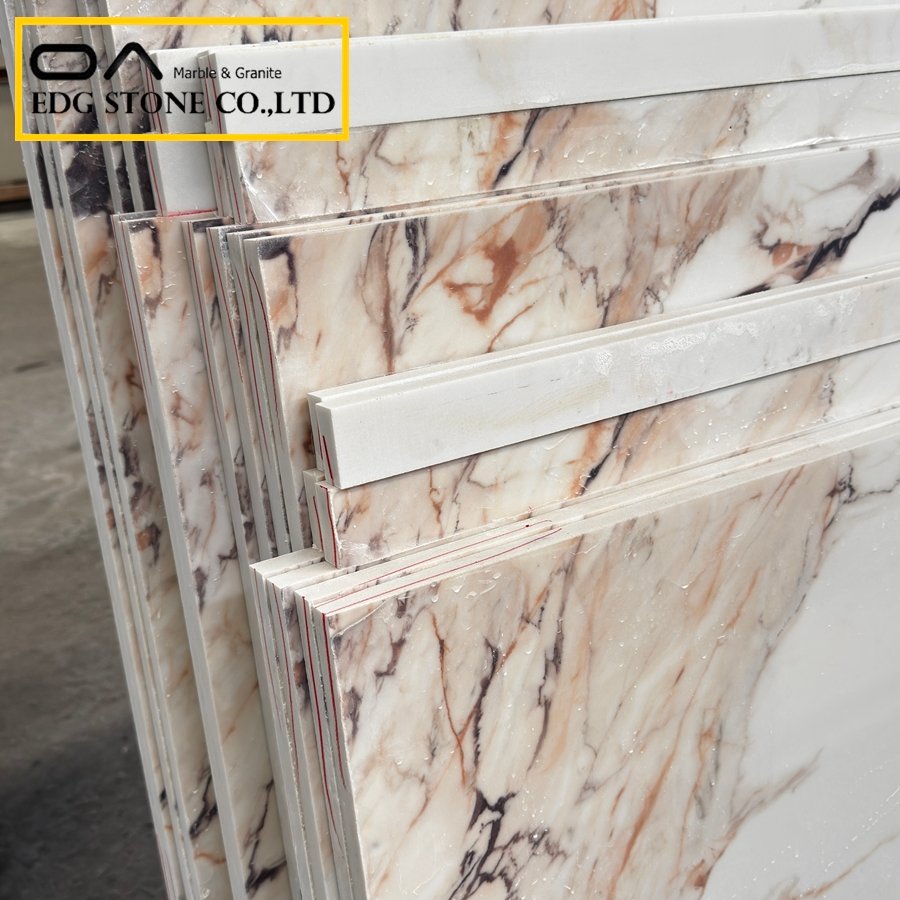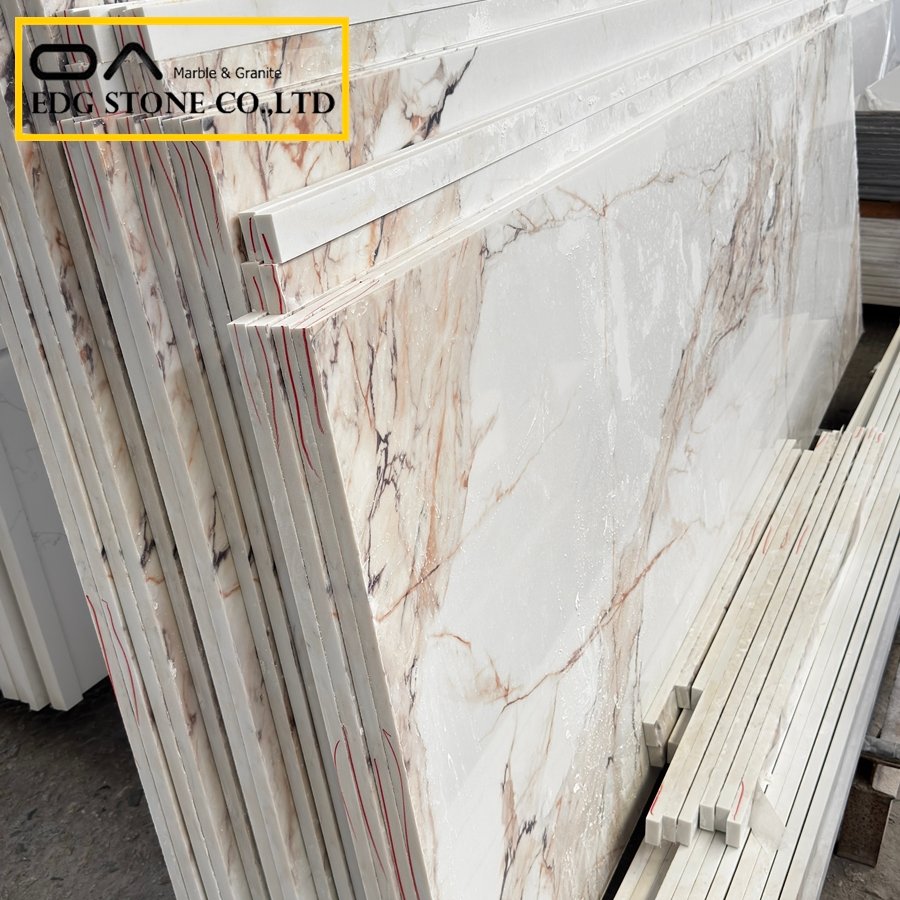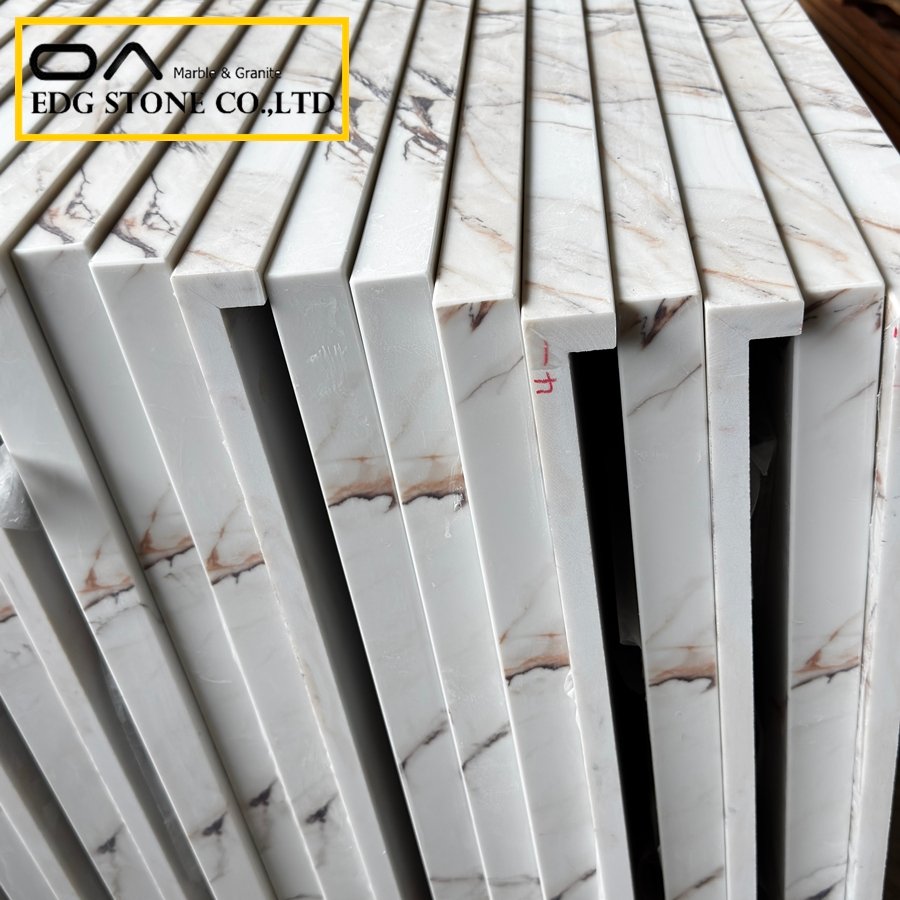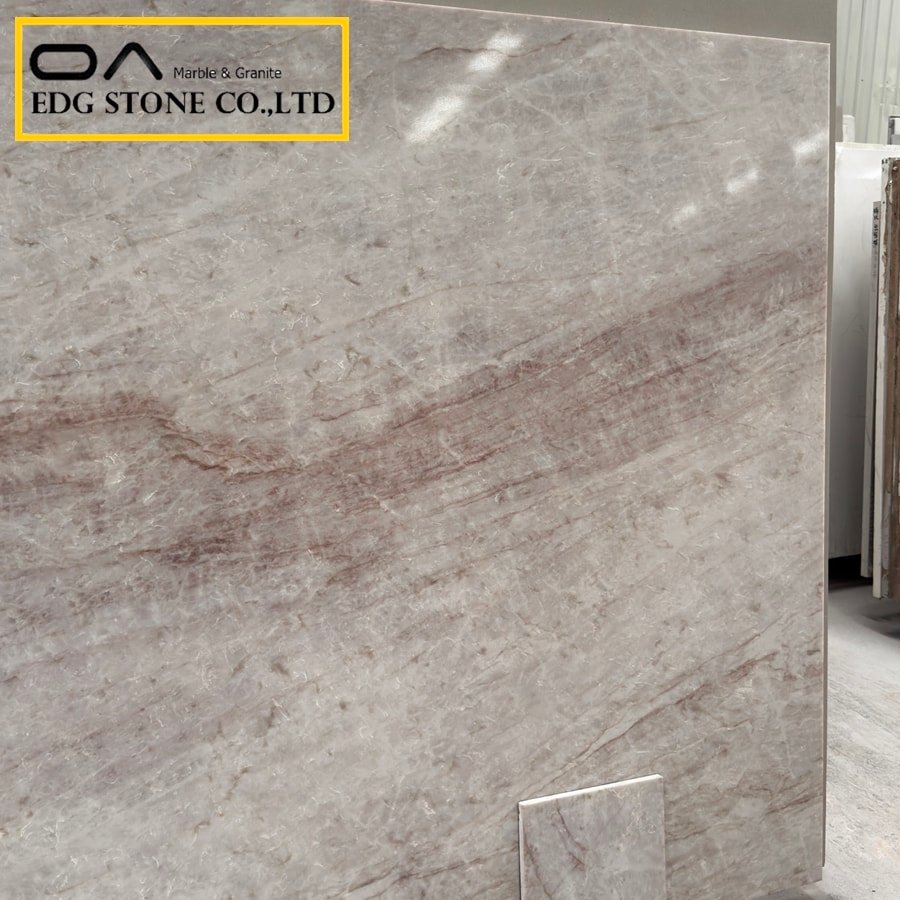

Intro: Why printed quartz matters now?
Table of Contents
Toggle- Intro: Why printed quartz matters now?
- 1) What is printed quartz?
- 2) How printed quartz is made — quick technical overview
- 3) The pros (advantages) of printed quartz
- 4) The cons (disadvantages/risks) of printed quartz
- A. UV / sunlight sensitivity — risk of fading or color change
- B. Surface-print layer: potential for wear if poorly manufactured
- C. Cleaning chemical compatibility — caution with wipes and harsh cleaners
- D. Fabrication health & environmental considerations (silica hazard)
- E. Variable quality between manufacturers/factories
- 5) Cleaning, maintenance, and the big question: “Can I use wipes on quartz?”
- 6) Safety, fabrication, and regulatory direction — what’s changing in the industry?
- 7) Buying checklist — what to ask your manufacturer/factory/wholesaler
- 8) Long-tail keyword suggestions (commercial intent + manufacturer/wholesale)
- 9) FAQ — Google hot-search style (5 items)
- Semantic Closure — How / Why / What / Options / Considerations
- Focus Keyword, Tags,
Printed quartz (sometimes called digitally printed quartz, printed engineered stone, or digital-surface quartz) is a recent evolution in engineered surfacing that layers high-resolution printed imagery into or onto the quartz slab surface so you can get very realistic marble, stone, timber, or bespoke graphics without the maintenance of natural stone. This post unpacks the technology, lists clear pros and cons, and addresses the top consumer questions (e.g., “Can I use wipes on quartz? Does printed quartz fade?”).

1) What is printed quartz?
Printed quartz is an engineered stone product where digital printing technology (high-resolution inkjet or UV printing) is applied either to the surface or incorporated into a thin top-resin layer to reproduce natural stone veining, textures, and bespoke imagery at scale. The printed image is fused, cured, and finished so that it looks like a continuous slab. Printed quartz aims to give the stylistic freedom of decorative surfaces while retaining engineered quartz’s non-porous, low-maintenance benefits. Recent product descriptions from manufacturers show printed quartz positioned as functionally similar to traditional quartz, with appearance as the main differential.
2) How printed quartz is made — quick technical overview
Base: starts with engineered quartz (crushed quartz mixed with polymer resins and pigments).
Printing: a high-resolution image (marble vein, wood grain, bespoke pattern) is printed either onto a cured panel or onto the top resin layer using specialist industrial printers and UV/heat curing.
Finish: the printed face is sealed and polished; certain processes embed the print slightly below the surface for wear resistance. Manufacturer pages and trade descriptions indicate printed and traditional quartz share core durability properties, but the visible pattern is produced by printing rather than pigment mixing alone.
3) The pros (advantages) of printed quartz
A. Design variety & realism
Extremely wide aesthetic range — from hyper-realistic Calacatta and marble grains to bespoke graphics or brand patterns. For architects and hospitality projects, this means consistent repeats and exact matching across slabs.
B. Non-porous, stain-resistant performance
Like other engineered quartz varieties, printed quartz is typically non-porous and resists stains and bacterial absorption, reducing sealing needs and ongoing maintenance.
C. Predictable and consistent inventory for projects
Digital printing allows near-identical slabs in multiple runs, easing multi-slab projects (hotels, restaurants, chain stores) where visual consistency is critical.
D. Durability (scratch & chip resistance similar to quartz)
The engineered quartz substrate gives strong scratch and chip resistance; the surface finish is factory-controlled for flatness and sheen. Industry overviews state printed quartz retains the durability of traditional quartz products, although top-layer care matters.
E. Cost and sourcing benefits (in some cases)
Printed surfaces can reproduce premium looks (marble, onyx) at lower overall material cost than rare natural stone and with more predictable lead times — useful for wholesalers and factories offering volume pricing.

4) The cons (disadvantages/risks) of printed quartz
A. UV / sunlight sensitivity — risk of fading or color change
Many engineered quartz products (including printed variants) are not formulated for prolonged outdoor exposure or direct, continual sunlight; some manufacturers warn that prolonged direct UV exposure can cause fading or yellowing over time. For indoor applications near large sunlit windows, consider placement and shading.
B. Surface-print layer: potential for wear if poorly manufactured
If the printed image is only surface-applied and not properly embedded or sealed, it could be more susceptible to abrasion or chemical attack than pigments mixed through the mass. Choose manufacturers who describe their print-embedding or top coat curing method.
C. Cleaning chemical compatibility — caution with wipes and harsh cleaners
Some disinfecting wipes and harsh cleaners contain acidic or alkaline chemistries (or solvents) that, with frequent use, can alter resin surfaces or affect printed inks. Industry care guides recommend mild soap and water or manufacturer-approved cleaners for daily care; reserve stronger disinfectants for occasional, controlled use per manufacturer guidance. Architectural & consumer guides caution against regular use of bleach/abrasive cleaners or certain disinfectant wipes.
D. Fabrication health & environmental considerations (silica hazard)
Cutting, grinding, and polishing engineered quartz (printed or not) generates respirable crystalline silica dust if performed dry. Worker safety regulations (and public health reports) have made silica control a central industry concern; manufacturing and installation must follow strict exposure controls (wet cutting, local exhaust ventilation, respirators, training). Regulators and health agencies (OSHA/CDC) emphasize exposure limits and controls.
E. Variable quality between manufacturers/factories
“Printed quartz” is a process term rather than a single standard; quality and durability vary by supplier. Vet manufacturers and ask for data: abrasion resistance, UV stability tests, warranty on colorfastness, and evidence that printing is embedded or well-sealed.
5) Cleaning, maintenance, and the big question: “Can I use wipes on quartz?”
Short answer: Occasionally, but cautiously — prefer manufacturer-approved cleaners and mild soap/water for daily use. Frequent use of disinfectant wipes that contain harsh solvents, citrus acids, or bleach may, over time, dull a resin surface or impact printed layers. Trusted cleaning guides and countertop-care resources recommend:
Daily: warm water + mild dish soap, microfiber cloth.
Stains: follow manufacturer instructions; baking soda paste or rubbing alcohol for hardened residues where advised.
Wipes: Use disinfecting wipes sparingly and rinse the surface afterward with water. Avoid continuous daily use of bleach- or solvent-based wipes unless the manufacturer confirms compatibility. Some cleaning advisories explicitly warn that frequent use of strong household disinfectants (e.g., some Clorox wipes variants) can, over time, affect quartz finishes.
Abrasives/Scouring pads: do not use — may abrade the printed finish.
Heat: avoid placing hot pans directly on the surface; use a trivet/mat.
UV exposure: Avoid long-term direct sunlight to reduce any potential for color shift.
Practical rule: Always check your slab supplier’s care guidance and ask about the resin/topcoat formulation and the recommended disinfectants; keep a labeled “approved cleaner” list for site staff or household members.
6) Safety, fabrication, and regulatory direction — what’s changing in the industry?
Worker health: respirable crystalline silica is the primary regulatory driver
Cutting and finishing engineered quartz releases respirable crystalline silica (quartz). OSHA, CDC, and other agencies have documented silicosis and lung disease from engineered stone fabrication and have strict standards for monitoring and exposure control. OSHA’s respirable crystalline silica standards for general industry and construction require exposure controls, training, medical surveillance, and written exposure-control plans. Several public health alerts and studies (including CDC/NIOSH summaries) underline the risk of silicosis among countertop workers.
Consumer labeling & warning regimes
In regions like California, crystalline silica is on the Proposition 65 list; manufacturers and sellers may need to update warnings or product communication reflecting silica content. This affects supply chains and may change how vendors label engineered stone in retail/wholesale packaging.
Trend: safer fabrication + offsite prefabrication & factory automation
To reduce on-site dust exposure and regulatory compliance risk, many suppliers are moving more cutting/finishing processes into controlled factory environments (automated CNCs with dust collection and wet machining). Buyers should verify manufacturer/factory compliance, ask for SDS (safety data sheets), and demand evidence of worker-safety procedures.
7) Buying checklist — what to ask your manufacturer/factory/wholesaler
Is the printed layer embedded (in-mass) or surface-applied, a nd how is it cured? (ask for technical sheet)
Do you have UV-stability or accelerated weathering test data for the printed surface? (Request test certificates)
Which cleaning products are approved? Any disinfectants/wipes to avoid?
What’s the warranty (colorfastness, surface wear), and what does it exclude?
Can you provide SDS, silica management plans, and evidence of factory controls (wet cutting, LEV)?
For volume purchases, ask for batch photographs and color-match guarantees across multiple slabs.
8) Long-tail keyword suggestions (commercial intent + manufacturer/wholesale)
printed quartz slab manufacturer wholesale
printed quartz countertops factory direct bulk price
printed quartz colorfastness UV test data manufacturer
printed quartz wholesale supplier OEM factory samples
digital printed quartz slab manufacturer export price quote
9) FAQ — Google hot-search style (5 items)
Q1 — Can I use wipes on quartz?
A1 — You can use disinfectant wipes on quartz occasionally, but do so cautiously: prefer manufacturer-approved wipes/cleaners and rinse the surface afterward. Frequent use of harsh chemical wipes (bleach, strong solvents, citrus acids) may dull or damage the resin/topcoat or affect printed inks over time. For daily cleaning, mild soap and water or an approved glass/quartz cleaner is recommended.
Q2 — Does printed quartz fade?
A2 — Printed quartz can be sensitive to prolonged direct sunlight; many manufacturers advise against prolonged outdoor exposure as UV can cause fading or yellowing over long periods. Indoors, normal daylight is less likely to cause rapid fading, but placements exposed to direct, continuous sun warrant shading or UV-protective measures.
Q3 — What are the negatives of quartz countertops?
A3 — Engineered quartz negatives include sensitivity to prolonged UV exposure (possible discoloration), potential damage from extreme heat (hot pans), and risk to workers during fabrication from respirable crystalline silica dust unless strict controls are in place. Printed variants add potential extra care for the printed surface (chemical and abrasion sensitivity depending on topcoat quality).
Q4 — How should I maintain printed quartz?
A4 — Use daily mild soap and water; wipe spills quickly; avoid abrasive pads and routine use of harsh chemical disinfectants. For stubborn marks, follow the slab maker’s instructions. Confirm approved cleaners with your supplier and preserve warranty terms.
Q5 — Are printed quartz slabs safe (toxicity, off-gassing)?
A5 — Finished slabs sold for interiors are typically processed and cured to meet VOC and product-safety rules for building materials, but buyers should request SDS and VOC test reports if low-emission performance is required. Fabrication dust (silica) poses the main safety hazard during cutting and finishing — ensure factory and installation teams follow respirable silica controls.
Semantic Closure — How / Why / What / Options / Considerations
Focus Keyword, Tags,
Focus Keyword: printed quartz countertops pros and cons
50 SEO tags (use across page tags, meta-keywords, or tag cloud):
printed quartz, printed quartz countertops, digital printed quartz, printed quartz pros cons, printed quartz durability, printed quartz fade, can i use wipes on quartz, quartz wipes safe, does printed quartz fade, quartz cleaning guide, quartz maintenance, UV resistance quartz, quartz manufacturer, quartz factory, printed quartz wholesale, printed quartz supplier, printed quartz warranty, quartz printed slab, engineered stone printed, quartz printed surface, quartz vs porcelain, quartz safety silica, silica regulations quartz, OSHA quartz standard, quartz fabrication safety, quartz SDS, proposition 65 quartz, quartz colorfastness, printed quartz testing, quartz UV test, commercial quartz for hotels, hotel vanity quartz, quartz bulk pricing, quartz OEM factory, quartz wholesale supplier, print-embedded quartz, printed quartz topcoat, how printed quartz is made, printed quartz installation, printed quartz cleaning wipes, disinfecting wipes quartz, quartz countertop disadvantages, best cleaners for quartz, quartz industry trends, printed quartz design, digital slab printing, quartz resale value, printed stone slab, quartz health risks.
